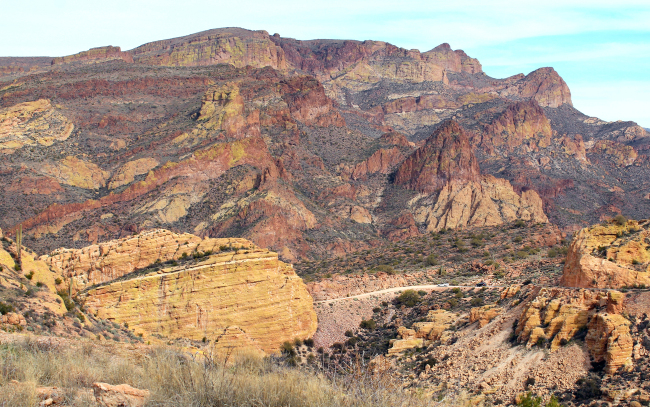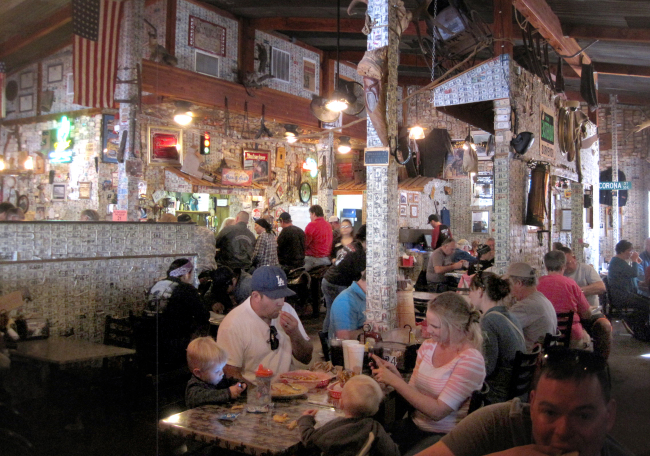My hands gripped the steering wheel. My right foot rode the brake. I was easing a four-wheel-drive rental down a steep, narrow, curving dirt road in the Arizona wilderness, and I was beginning to wonder what I’d gotten myself into.
On the passenger side, a towering craggy stonewall threatened to dent the car and make me regret that I had declined the rental company’s insurance coverage. Still, I stayed as close to that wall as I dared. On the driver’s side was a fate worse than a scrape: an abrupt plunge into a canyon so deep I couldn’t see the bottom.
At a bend in the tight road, a new challenge loomed. A Ford F-150 was headed my way -- and it was towing a fat speedboat. I pulled over where an extra few feet of road was as good a turnout as I’d get, and prepared to eat his dust.
This particular white-knuckle stretch of graded gravel, which drops 460 meters in 5 kilometers, is part of the Apache Trail. I drove that 193-kilometer ring road east of Phoenix one January day with my uncle and sister. While the route twists, rises and falls, sometimes precariously, much of it is now paved and less nerve-racking.

The road follows an age-old footpath mapped out by Indians and encircles the Superstition Mountains, known for spires of red-brown rock called hoodoos. It passes ghost towns repopulated for tourists, Saguaro-studded landscapes and 700-year-old cliff dwellings. It also leads to the 1911 Roosevelt Dam, a structural wonder that gave modern Arizona its foothold by providing water and electricity for much of the central part of the state, including Phoenix. The dam spurred the development of the road in the first place; it was the route used to get construction equipment to the site.
I was only a quarter of the way around it when I hit that sharp descent, but I already knew the road would deliver the Arizona I’d come to experience, all in a day’s drive — thrilling, beautiful, historic and wild.
We headed out from my uncle’s house in Sun City West in the morning, and turned onto the Apache Trail just when one of the first tourist stops along the way, the Goldfield Ghost Town, opened for business at 10 a.m.
Goldfield is the kind of place that serves “vittles” (at Mammoth Steakhouse), lets you dress up for an antique-looking photograph (at Time After Time), sells sterling silver jewelry (at the Blue Nugget) and announces itself with a weathered wooden sign that reads “Arzona Territory 1893.” We approached with a shrug, wondering if the tourist kitsch would ruin the experience. Turns out, the opposite was true.
The buildings in Goldfield may be replicas -- the actual ghost town had little more than foundations and a few shacks before it was rebuilt in the 1980s -- but they look authentically ramshackle, with rusted horseshoes adorning a wall and shovels hanging in rows like an old-time art installation. It is a pleasant place to wander and pop into shops selling pottery, candy and the inevitable T-shirt.
Tourist gold
My uncle and sister soaked up the soft sun along the town’s dusty lanes. I headed underground for a tour of the replica gold mine and a lesson in old Arizona, when dreamers began populating the desert and chasing riches.
A handful of other early birds and I followed our guide down a set of stairs, then into an elevator that shimmied and shook. If it was a fake ride downward, I was convinced. When we stepped out the other side of the elevator, we were in a claustrophobic, dimly lit underground tunnel, akin to those where miners engaged in the dangerous work of extracting gold from solid rock.
“You were down here breathing silica dust. If you got silicosis, you might have six months to live. But that was OK -- you were getting paid $3 a day,” said our guide Cousin Jack, a bearded and good-natured man who stayed in character as an 1890s miner.
We learned the facts down below: The mine produced 1,417 kilograms of gold. Jackhammers were introduced in late 1800s. Miners had no aboveground bathroom breaks, though they could sit on a toilet (with wheels, so the early porta-potty could roll out of the mines); we saw the rusted remains. But the most memorable moment came in an instant, when Cousin Jack turned off the light switch to demonstrate why miners wore headlamps powered by candles. There was utter blackness.
Above ground, I found my family and we headed up the road a mile to Lost Dutchman State Park, where we stopped primarily to take in the stunning views of the Superstition Mountains from a native plant path. Park hiking trails lead into the Superstition Wilderness Area, but they would have to wait for another trip. Hunger pangs inspired us onward.

When we pulled into Tortilla Flat, an old stagecoach stop on the Apache Trail, people milled about on the wooden walkway outside the Superstition Saloon, so I braced for a long wait. No need. I dropped my uncle and sister at the door, and they were already seated by the time I parked the car, passed a fake Wild West shootout spectacle complete with cancan girls, and found my way to the restaurant.
Inside, patrons sat on worn leather horse saddles at the bar. Dollar bills covered the walls. “There’s about $300,000 stapled up here,” our waiter told us, with no further explanation, after I tucked into the booth.
The place is known for “killer chili,” but I opted for chicken enchiladas. They were not excellent or killer, but they were not as bad as you might expect of a place that is positioned perfectly for a noon stop along the Apache Trail, with no competition in sight. If we wanted excellence, well, at least we had my aunt’s chocolate chip cookies in the car.
Wilderness around the bend
As the car splashed over a trickle of a creek just beyond Tortilla Flat, the tourist traps seemed to wash away. The pavement ended and the road slowly curved and climbed.
For 64 twisting kilometers, little lined the road but desertscapes, and the car’s windows framed views of Arizona’s stark beauty. Buttes jutted into pure blue skies. Cliffs striped with yellow, red and brown rock rose above the hillsides. Saguaro cactus, some 200 years old, dotted the scene, lording over an arid world that could kill other species who aren’t as well prepared -- humans, for instance.
Then, just as I was feeling stiff from too much time behind the wheel, we came upon an overlook for the Roosevelt Dam, the structure that has done so much to make the dry land hospitable. With its power and water supply, we build homes and hotels with swimming pools and regard the once-dangerous desert from those air-conditioned perches.
When the dam was being built in the early 1900s -- mostly by Italian stone masons and Apache Indian laborers -- granite forged from the mountainside became building blocks. Although a 1989 upgrade covered that work with concrete, the 110-meter structure is still impressive in its enormity. At the overlook, we were as high as the top of the dam itself -- so high that a group of sightseers debated whether the flashes of water we saw far below in the reservoir were the product of jumping fish or bathing ducks. Ducks, was the consensus.
Back at the car, I took out the rudimentary map I had printed off the Internet.
It was 3 p.m., so I broke the news to my passengers gently.
“Looks like we’re halfway done,” I said, and was met with looks of concern and bemusement. There was nothing to do but carry on.
But soon after turning out of the parking lot, we hit pavement. Another mile or so, and we were on a highway, where we happily zipped along until we came to our last stop of the day.
We arrived at Tonto National Monument with little time to spare before it closed at 5 p.m. My uncle stayed at the museum, but my sister and I hiked briskly up a cactus- and mesquite-lined walkway to the remains of a small cliff dwelling.
A cave’s rounded opening framed the straight stone walls, as though it were a shadowbox. The room had been built 700 years ago by farmers known as the Salado people. It was striking to peer into their home, see their fingerprints left behind in the adobe and a ceiling still blackened from their cooking fires.
Archaeologists know relatively little about the group, except that they lived there year-round, farmed irrigated fields and traded with people from far away (seashells and macaw feathers were among their possessions). Clearly, they had adapted to the harsh environment -- even without the benefits of Roosevelt Dam.
As we headed back to the car, dusk was setting in. Our long, wild ride -- on highways and dirt roads, from hydroelectric dams to ancient dwellings -- was over, and I was glad it ended at a place that celebrates the oldest of old Arizona. (Tribune Content Agency)


![[AtoZ into Korean mind] Humor in Korea: Navigating the line between what's funny and not](http://res.heraldm.com/phpwas/restmb_idxmake.php?idx=644&simg=/content/image/2024/04/22/20240422050642_0.jpg&u=)
![[Exclusive] Korean military set to ban iPhones over 'security' concerns](http://res.heraldm.com/phpwas/restmb_idxmake.php?idx=644&simg=/content/image/2024/04/23/20240423050599_0.jpg&u=20240423183955)


![[Graphic News] 77% of young Koreans still financially dependent](http://res.heraldm.com/phpwas/restmb_idxmake.php?idx=644&simg=/content/image/2024/04/22/20240422050762_0.gif&u=)

![[Herald Interview] Why Toss invited hackers to penetrate its system](http://res.heraldm.com/phpwas/restmb_idxmake.php?idx=644&simg=/content/image/2024/04/22/20240422050569_0.jpg&u=20240422150649)





![[Exclusive] Korean military to ban iPhones over security issues](http://res.heraldm.com/phpwas/restmb_idxmake.php?idx=652&simg=/content/image/2024/04/23/20240423050599_0.jpg&u=20240423183955)



![[Today’s K-pop] Ateez confirms US tour details](http://res.heraldm.com/phpwas/restmb_idxmake.php?idx=642&simg=/content/image/2024/04/23/20240423050700_0.jpg&u=)